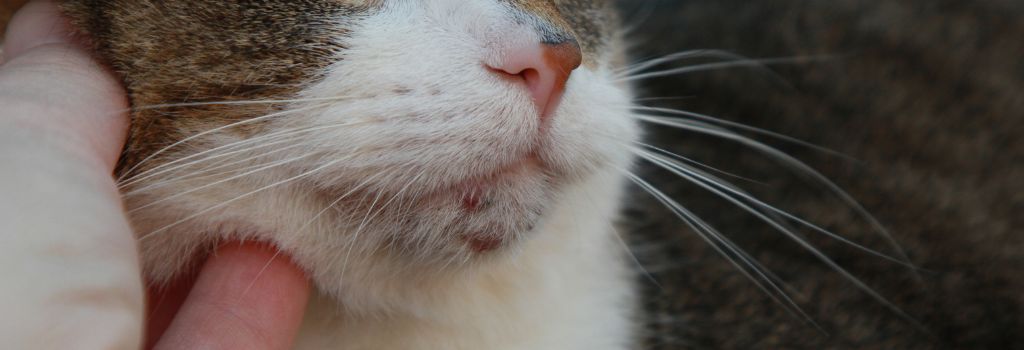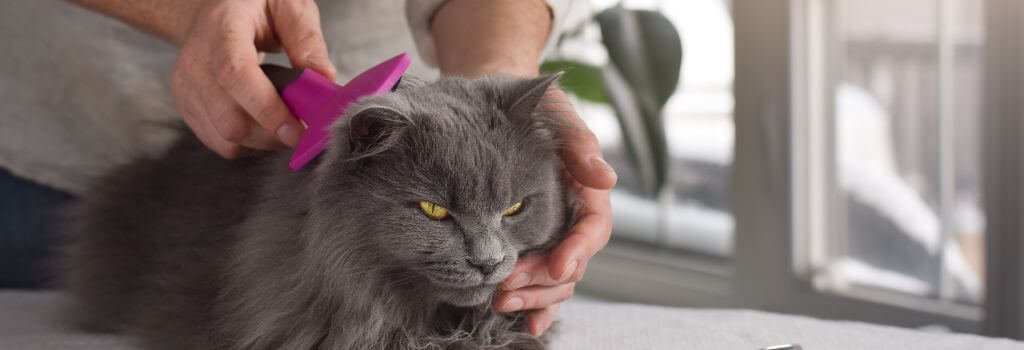When I think of acne, I’m instantly transported back to middle school me — awkwardly putting on way too much foundation in a shade that didn’t even slightly match my skin tone, all in a desperate attempt to conceal the unconcealable. The struggle was (let’s be honest, is) real!
This struggle is also real for our cats! Did you know our cats can also have their own version of acne? Unlike us, though, they don’t have the luxury of concealer, Instagram tutorials, or a handy beauty blender. That’s where we come in as pet parents. We must help our feline friends navigate their dermatological distress. So, let’s take some time together to understand more about this skin struggle our cats may face and learn how we can support our kitty’s complexion.
What Is Cat Acne?
Feline acne is a surprisingly common condition that can affect cats of any age or breed. If you’ve ever noticed your cat’s chin looking a little “dirty” or crusty, you might be dealing with this peculiar skin issue.
But what exactly is cat acne, and how does it compare to the breakouts we humans know all too well?
While cat acne and human acne share one key feature — clogged hair follicles — they’re not quite the same thing. Human acne is often fueled by hormones, bacteria, and overactive oil glands, which is why it tends to make its grand appearance during our teenage years. Cats, however, don’t deal with hormonal fluctuations like we do. Instead, feline acne is caused by a buildup of keratin, a natural protein found in the skin, within the hair follicles, and typically happens on the chin and lip regions. This clogging leads to blackheads (also known as comedones), and in more severe cases, it can progress to inflammation, swelling, or even pustules.
The good news is that cats aren’t nearly as self-conscious about their acne as we are. While we might agonize over every blemish, your feline friend probably won’t even notice their chin breakouts unless they become severe or infected. Since feline acne isn’t typically painful or itchy, it’s easy to miss. However, catching it early and taking action can help prevent complications and keep your cat’s chin looking clean and healthy!

What Causes Cat Acne?
The exact cause of cat acne remains a bit of a mystery, but we do know there are some factors that can contribute to feline chin breakouts. From keratin buildup to allergies, stress, or even the type of food bowl your cat uses, a variety of triggers might be at play. While we may not have all the answers, understanding these potential culprits can help keep your cat’s skin in the clear.
- Allergies: Both food and environmental allergies can predispose cats to acne.
- Poor Grooming: Cats that don’t clean themselves efficiently may be more prone to clogged follicles.
- Contact Hypersensitivity: Plastic food bowls and other porous materials can irritate your cat’s skin, making acne more likely.
- Stress: Just like humans, cats can experience stress-related skin conditions.
- Viruses: Some evidence links feline acne to viral infections like herpesvirus or calicivirus.
- Other Culprits: Overactive sebaceous glands, autoimmune disorders, or skin conditions like ringworm and demodex might also play a role.
Signs of Feline Acne
Cat acne can show up in a variety of ways, from mild to more severe cases. You might notice tiny black dots (blackheads) on your cat’s chin or lip margins in its mild form. These comedones can make the area look dirty, crusty, or slightly bumpy, and you might even spot some missing fur.
In more serious cases, our cat’s skin can become much worse. The chin or lip margins may become swollen and thickened, with draining pustules or small spots of blood. Your cat might rub their chin on furniture or paw at the area, but surprisingly, it’s not normally painful or itchy. Severe acne can sometimes come with other skin issues, like redness, hair loss, or excessive grooming, especially if allergies are involved. If you spot any of these symptoms, whether it’s a few blackheads or a more serious breakout, it’s best to have your pet seen by a veterinarian to help determine the cause and see if treatment may be necessary.
Diagnosing And Treating Cat Acne
Since cat acne shares symptoms with other skin conditions, your veterinarian will likely start by ruling out other possibilities first. A thorough physical exam from whiskers to tail and other tests such as blood work, urine analysis, or skin cultures may be recommended to uncover any underlying allergies, infections, or other contributors.
A cell biopsy may be necessary for more complex cases to confirm the diagnosis. Conditions like ringworm, demodicosis, or eosinophilic granuloma complex can look suspiciously similar to cat acne, which will help confirm your pet’s diagnosis more thoroughly.
Once the diagnosis is in, the treatment plan for your cat’s skin will depend on how severe your cat’s acne is.
Mild Cases
For mild breakouts, the solution can be as simple as daily cleaning. Medicated shampoos or antibacterial wipes containing sulfur-salicylic acid or benzoyl peroxide work wonders in clearing up blackheads. Switching out plastic food bowls for stainless steel or ceramic ones (and washing them regularly) can also help reduce irritation and prevent future flare-ups.
Severe Cases
If your cat’s acne has progressed to more noticeable swelling, redness, or infection, it may require a bit more TLC. Your vet might prescribe oral antibiotics or topical treatments like ointments or creams to tackle secondary infections and soothe inflamed skin. Fatty acid supplements, such as omega-3 and omega-6, can also give their skin a health boost by reducing inflammation.
For particularly stubborn cases, more advanced treatments may be needed. Options like isotretinoin or even pheromone therapy can make a difference, especially when traditional methods aren’t successful. Whatever the treatment, it’s important to follow your veterinarian’s guidance closely to make sure your cat gets the best care.

Preventing Cat Acne
While it’s not always possible to prevent feline acne entirely, there are a few simple steps you can take to reduce the chances of it happening or coming back:
- Switch to Non-Plastic Bowls: Switch to stainless steel or ceramic food and water bowls. Plastic can harbor bacteria and irritate your cat’s skin, so opting for non-porous materials and washing them regularly is a game-changer.
- Maintain Good Hygiene: Brush your cat, clean their chin, and bathe them as needed to help prevent buildup.
- Address Underlying Issues: If your cat has allergies or other skin conditions, addressing those promptly can help minimize acne flare-ups.
- Reduce Stress: Create a calm environment to help manage stress-related acne.
When to See a Specialist
If your cat’s acne doesn’t improve with standard treatments or seems to be getting worse despite your best efforts, your veterinarian may recommend seeing a board-certified veterinary dermatologist. These specialists are experts in diagnosing and treating complex and persistent skin conditions and can provide advanced, tailored treatment specifically for your unique pet.
Remember, your veterinarian is your best asset when navigating your cat’s health. Whether it’s managing mild acne or consulting a specialist for more stubborn cases, they’ll be there to guide you. With a little effort and attention, your cat will be back to looking and feeling their best, and best of all, no concealer required!
If you have questions and you'd like to reach out to us, you can call us directly at (817) 270-9416 , or you can email us at grote@riverstonevetgroup.com. Don't forget to follow us on social media Facebook, Instagram.

